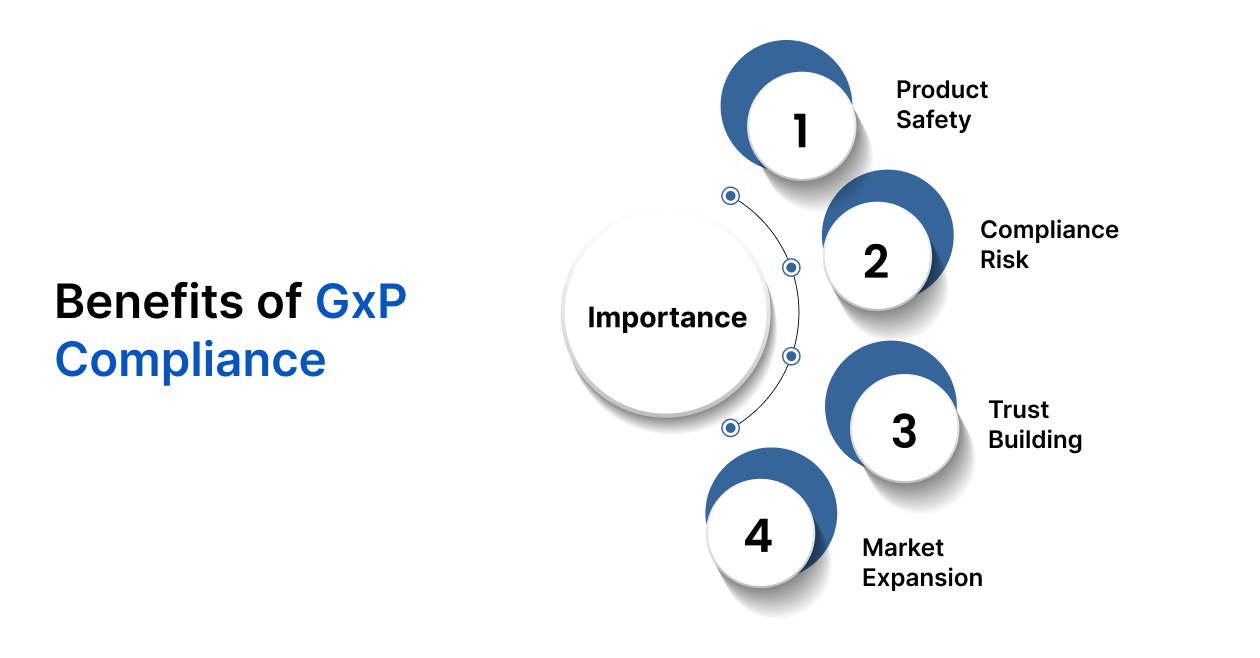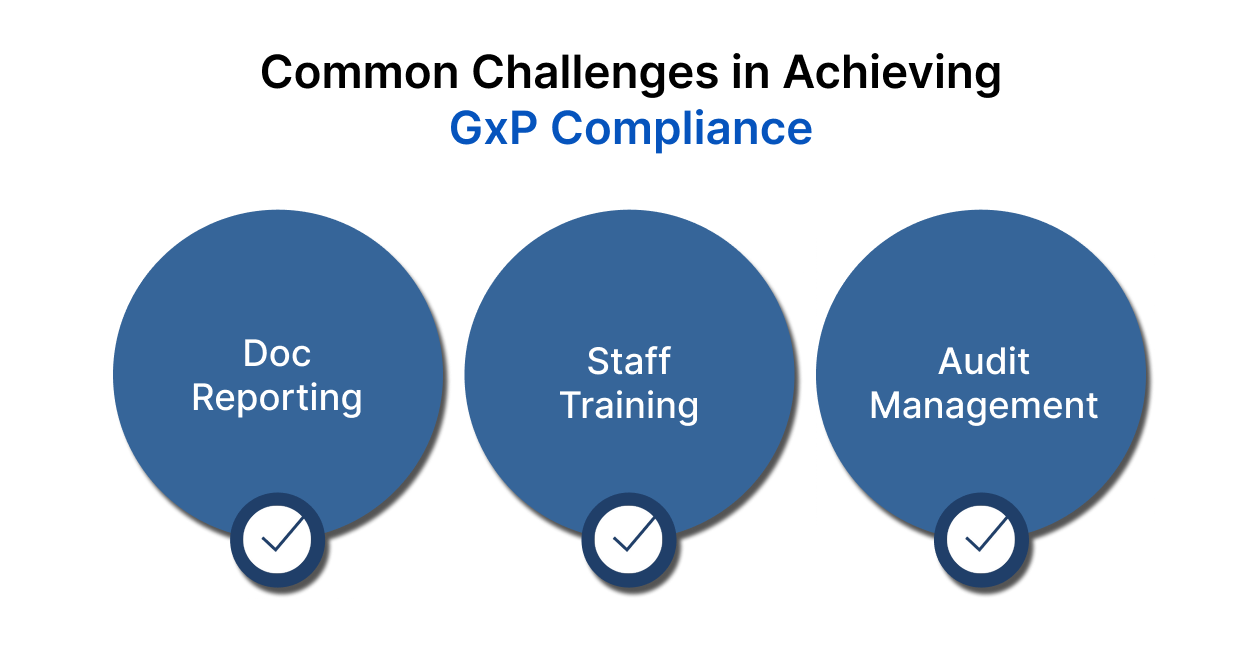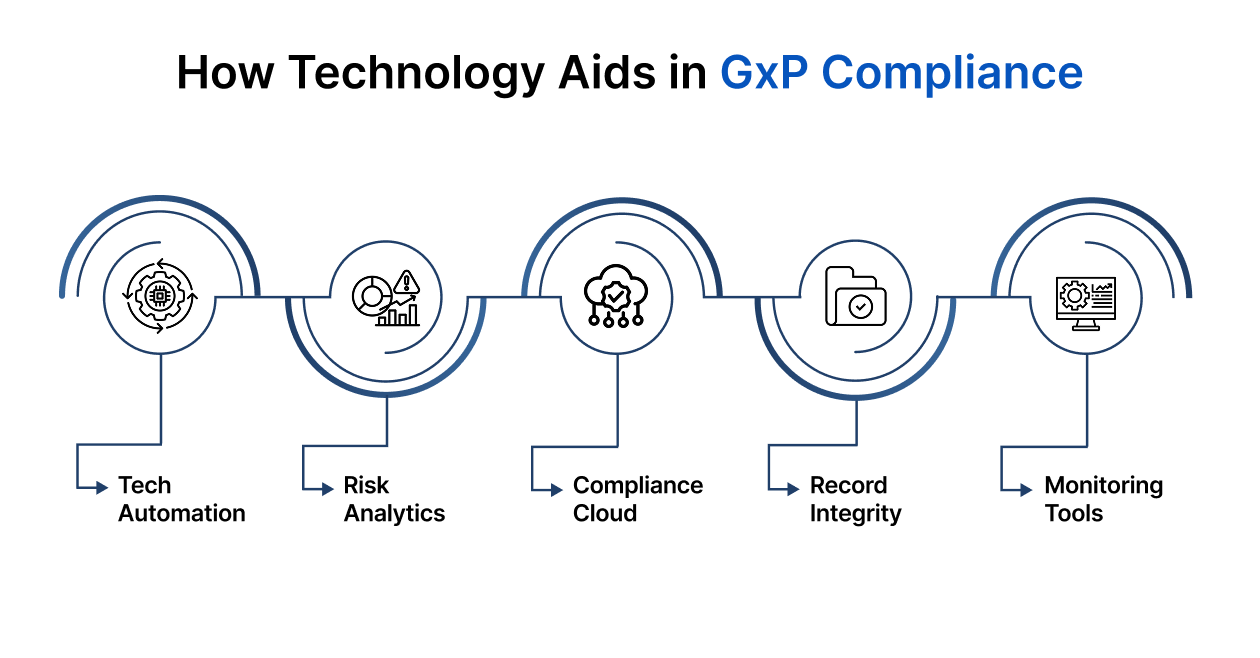Regulations in the pharmaceutical and MedTech industries are becoming increasingly complex. With the global pharmaceutical regulatory affairs market projected to reach nearly USD 9.5 billion in 2024, organizations face growing pressure to stay compliant. For these companies, compliance isn’t just a regulatory requirement—it’s crucial for ensuring product safety, maintaining quality standards, and protecting brand reputation. Non-compliance can lead to costly fines and recalls, making a proactive compliance framework essential. That’s where GxP comes in, offering a solid foundation to help businesses stay compliant and operate efficiently. This article will dive into what GxP compliance really means and why it’s becoming more essential than ever in such a tightly regulated space.
What is GxP Compliance?
GxP stands for “Good Practices” in the manufacturing, testing, and distribution of pharmaceutical products, biologics, vaccines, medical devices, and more. It encompasses a set of regulations and guidelines set by regulatory bodies such as the FDA and WHO.
Understanding GxP compliance entails crucial work, but to implement it effectively, it’s important to break down its key components. Here are the key components of GxP compliance and how they contribute to maintaining regulatory standards.
Key Components of GxP Compliance
GxP compliance includes several critical areas that pharmaceutical and life sciences companies must adhere to. These guidelines ensure consistency, accuracy, and quality control in manufacturing, testing, and distribution.
1. Good Manufacturing Practices (GMP)
GMP ensures products are consistently produced to meet quality standards. It covers everything from raw materials, facility cleanliness, equipment maintenance, to employee training, aiming to minimize risks like contamination and errors.
2. Good Clinical Practices (GCP)
GCP ensures the integrity of clinical trials by providing guidelines for trial design, conduct, and reporting. It safeguards patient rights and ensures the reliability and credibility of collected data.
3. Good Laboratory Practices (GLP)
GLP ensures laboratory testing integrity, particularly in preclinical studies. It ensures that processes are structured, documented, and reproducible to maintain accuracy and consistency in research and development.
4. Good Distribution Practices (GDP)
GDP ensures products are stored, transported, and handled under proper conditions throughout the supply chain, including temperature control and product integrity, ensuring drugs and medical devices maintain quality until reaching consumers.
5. Good Pharmacovigilance Practices (GVP)
GVP focuses on monitoring the safety of pharmaceutical products post-market by tracking adverse drug reactions and conducting risk assessments to safeguard public health and mitigate associated risks.
Benefits of GxP Compliance

Maintaining GxP compliance isn’t just about meeting regulatory requirements—it’s a strategic investment in quality, safety, and operational excellence. Below are some core benefits that GxP compliance brings to life sciences businesses:
1. Ensuring Product Safety and Quality
GxP guidelines are designed to safeguard product quality, ensuring that drugs, medical devices, and other regulated products are safe for use. By adhering to these practices, manufacturers can avoid contamination, defects, and recalls, ultimately ensuring consumer safety.
2. Reducing Risk of Non-Compliance Penalties
Failing to comply with GxP regulations can lead to serious consequences, including fines, product recalls, and reputational damage. Organizations that maintain GxP compliance are less likely to face penalties and are better positioned to respond to regulatory audits and inspections.
3. Building Trust with Regulatory Bodies and Consumers
GxP compliance boosts an organization’s credibility with regulatory bodies, customers, and stakeholders. Adherence to industry standards demonstrates a commitment to quality and transparency, which builds trust and enhances business reputation.
4. Growing Market Access
Maintaining GxP compliance expands market access by ensuring that products meet the stringent requirements of different regions and regulatory bodies. This opens doors to new markets and facilitates the approval process for international distribution, helping companies grow and stay competitive in a global market.
GxP Compliance Checklist
Maintaining GxP compliance requires careful planning, documentation, and regular audits. Here’s a checklist that organizations can use to stay on track:
- Understand Regulatory Requirements
Familiarize yourself with the relevant GxP guidelines for your industry, including FDA regulations, EMA guidelines, and other applicable regulatory bodies.
- Develop a Compliance Strategy
Create an internal strategy to meet GxP standards, which includes training employees, maintaining proper documentation, and setting up internal audits.
- Maintain Detailed Documentation
Accurate record-keeping is vital for GxP compliance. All manufacturing, testing, and distribution processes should be documented thoroughly to ensure accountability and transparency.
- Implement Data Integrity Measures
Ensure that data integrity is preserved across all stages, from research and development to post-market surveillance. Utilize technology to maintain accurate and accessible records.
- Regular Inspections and Audits
Schedule periodic audits and inspections, both internal and external, to assess compliance and identify areas for improvement.
Common Challenges in Achievng GxP Compliance

Achieving and maintaining GxP compliance is an ongoing process that requires continuous effort, resources, and attention to detail. While the benefits of compliance are clear, organizations often encounter several challenges along the way.
1. Complex Documentation and Reporting
The sheer volume of documentation required for GxP compliance can be overwhelming. Keeping accurate records across multiple departments, facilities, and product lines requires robust systems and processes.
2. Ensuring Consistent Staff Training and Awareness
Keeping employees updated on GxP standards and ensuring they are properly trained can be resource-intensive. Regular training sessions are necessary to ensure that employees understand the importance of compliance and the role they play in maintaining it.
3. Managing Continuous Audits and Inspections
GxP compliance requires constant monitoring, audits, and inspections to ensure that standards are consistently met. These audits can be time-consuming and may require additional resources, especially for large organizations.
How Technology Aids in GxP Compliance

The rise of technology has greatly improved the ability of organizations to achieve and maintain GxP compliance. Modern tools and software solutions provide powerful ways to streamline documentation, ensure data integrity, and facilitate regular audits, making compliance more manageable and efficient.
1. Automation and Software Solutions
Technology plays a significant role in automating various GxP compliance tasks. Document management systems, audit tools, and electronic signatures can simplify the documentation process and ensure accurate record-keeping.
2. Risk Management and Predictive Analytics
Machine learning algorithms and predictive analytics can help organizations anticipate compliance risks before they occur. By analyzing historical inspection data, organizations can identify trends and take proactive measures to avoid non-compliance issues.
3. Cloud-Based Compliance Management
Cloud-based solutions allow for real-time access to documents and data from anywhere, ensuring that teams across different locations can collaborate efficiently and remain aligned with compliance standards.
These platforms can also integrate with other systems, creating a seamless flow of information and eliminating errors that can arise from manual data entry.
4. Data Integrity and Electronic Records
Technology helps maintain the integrity of data through the use of secure electronic records. Advanced encryption and secure authentication methods protect sensitive information, ensuring that data remains accurate, complete, and accessible for audits. This is especially important for maintaining compliance with regulatory requirements like 21 CFR Part 11, which governs electronic records in the pharmaceutical industry.
5. Real-Time Monitoring and Reporting Tools
Technologies that provide real-time monitoring of manufacturing processes, equipment, and data help ensure that any deviations from established standards are detected and addressed immediately. Automated reporting tools can streamline the process of creating compliance reports, making audits smoother and more efficient.
In addition to the technological advancements discussed, organizations in the pharmaceutical and MedTech industries can benefit from specialized platforms like Atlas Compliance, designed specifically to handle the complexities of regulatory compliance.
Atlas Compliance Solutions for GxP Compliance
Atlas Compliance, an AI-powered platform designed to assist pharmaceutical manufacturers in navigating the complexities of regulatory compliance, particularly concerning FDA inspections. By transforming fragmented FDA data into actionable insights, Atlas enables organizations to stay inspection-ready and proactively manage compliance risks.
With AI-powered tools and comprehensive data insights, Atlas Compliance provides an essential edge for companies aiming to stay GxP-compliant and proactively manage FDA inspection risks.
Key Solutions Offered by Atlas Compliance
1. FDA Inspection Intelligence
Atlas provides access to an extensive database of FDA inspection reports, including 483s, warning letters, and CFR citations. This enables organizations to stay informed about common compliance issues and proactively address potential risks before an inspection occurs.
2. AI-Powered Document Search
Using advanced Natural Language Processing (NLP) technology, Atlas streamlines the search for relevant documents within regulatory materials. This enhances efficiency, ensuring that companies can quickly identify the most pertinent information without sifting through vast amounts of paperwork.
3. Predictive Compliance Analytics
Atlas’s machine learning algorithms analyze historical inspection data to predict potential compliance issues, helping companies identify trends and take preventative actions. This proactive approach minimizes the risks associated with non-compliance and allows for better preparation for audits.
4. Supplier Risk Management
Atlas Compliance also offers tools to assess and monitor supplier performance. This ensures that all external partners meet regulatory standards, protecting your supply chain and maintaining the integrity of your products.
5. Regulatory Surveillance
Atlas continuously tracks regulatory changes, alerting organizations to new or updated compliance requirements. This ensures that companies can swiftly adapt to any changes in regulatory standards, keeping them on track with GxP compliance at all times.
By integrating Atlas Compliance into their workflow, organizations can significantly reduce the complexities of maintaining GxP compliance while improving operational efficiency and risk management. As GxP compliance becomes more crucial to business success, using platforms like Atlas can provide the technological support needed to streamline processes and safeguard product quality.
Conclusion
GxP compliance plays a critical role in protecting product quality, safety, and integrity in the life sciences industry. Staying compliant isn’t always easy, but the payoff is worth it, from avoiding regulatory fines to building lasting trust with customers and protecting your company’s reputation.
Life sciences companies should invest in reliable processes and tools to stay compliant and prepared for inspections. This includes using automation to reduce manual errors, applying data insights to anticipate risks, and continuously monitoring operations to ensure standards are met every step of the way.
Ready to simplify your GxP compliance? Discover how Atlas Compliance can help streamline your regulatory efforts and keep you compliant with our AI-powered platform. Request a demo today and take the first step toward efficient, proactive compliance management.